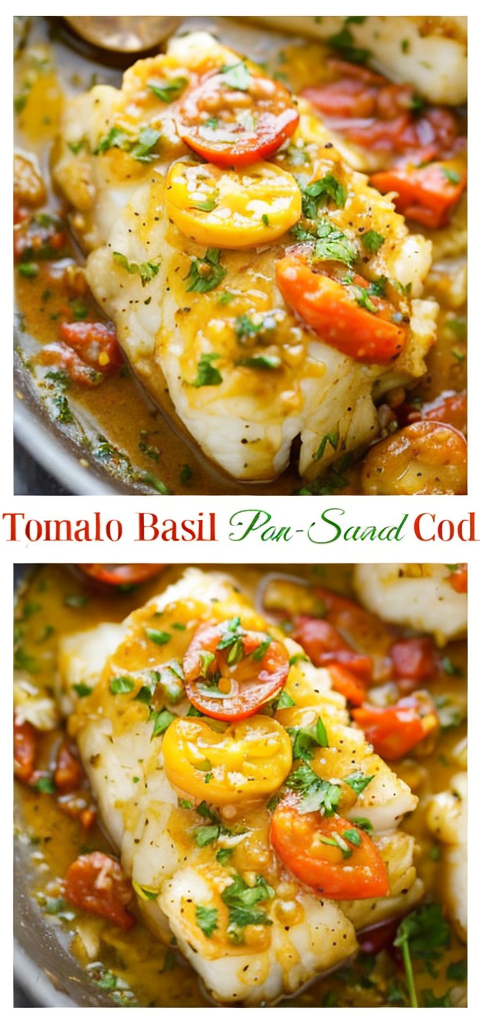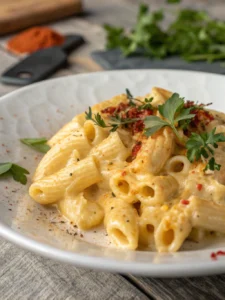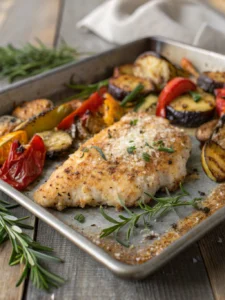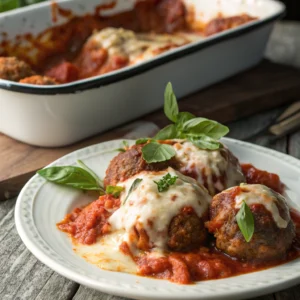Best Pan-Seared Cod in Sauce – Ready in 30 Minutes
The Best Pan-Seared Cod in Sauce is a straightforward recipe that radiates elegance without requiring a chef’s expertise. This dish, ready in just 30 minutes, showcases the flaky, tender nature of cod, perfectly complemented by a smooth, flavorful sauce. Ideal for a weeknight family dinner or a sophisticated meal with friends, this recipe will elevate any occasion with its rich taste and delightful presentation.
Pan-seared cod is celebrated for its delicate texture and mild flavor, making it an ideal canvas for a vibrant sauce. The interplay of a tender fish and a sauce that’s both creamy and slightly tangy brings about a harmony of flavors that dance on your palate. The flaky cod fillets soak up the luscious sauce, ensuring every bite is a melt-in-your-mouth experience.
Quick Recipe Highlights
- Flavor Profile: The dish offers a delectable balance of mild fish enriched by a creamy, slightly tangy sauce.
- Texture: The cod is wonderfully flaky, perfectly enhanced by the velvety texture of the sauce.
- Aroma: The citrusy, fragrant aroma wafts from the pan-seared cod, inviting a scrumptious taste.
- Visual Appeal: A golden crusted cod fillet nestled in a pool of creamy sauce, garnished with fresh herbs.
- Skill Level Needed: This recipe is suitable for beginners; techniques include simple pan-searing and sauce preparation.
- Special Equipment: A non-stick skillet for an even sear is essential.
Recipe Overview
- Difficulty Level: This is an easy-level recipe. Pan-searing the cod requires attention to maintain the fish tender yet flaky, while the sauce is a one-pot wonder.
- Category: This versatile dish suits both everyday meals and special occasions.
- Cuisine: The recipe leans towards Mediterranean influences, with its use of citrus and fresh herbs.
- Cost: Cod and basic pantry ingredients keep the budget modest, around $20 for four servings.
- Season: Best in spring and summer when fresh herbs and citrus are freshest but delicious year-round.
- Occasion: Perfect for a weeknight family dinner or a quick, elegant meal for entertaining guests.
Why You’ll Love This Recipe
The taste and texture of this pan-seared cod are unparalleled; the tender, flaky fish pairs impeccably with a rich and creamy sauce that adds depth and complexity to the meal. Its quick preparation allows you to enjoy a restaurant-quality dish at home, making it a convenient choice for busy weekdays.
Nutritionally, cod is low in fat but high in protein, making it a healthy meal choice that doesn’t compromise on taste. This recipe ensures you get the nutritional benefits without the guilt.
Entertaining becomes effortless with this dish. It’s an impressive addition to dinner parties, offering your guests an unforgettable culinary experience without needing extensive prep or advanced cooking skills.
Cost-effective and accessible, this recipe uses simple ingredients you’re likely to have on hand, driving down expenditure while still delivering flavor-packed satisfaction.
Historical Background and Cultural Significance
Cod has been a cornerstone in many culinary traditions across the globe due to its mild flavor and versatility. Its understated taste has allowed it to adapt to numerous recipes, from British fish and chips to Mediterranean delights.
Culturally, cod has sustained communities and economies, especially in Northern Europe, where it has been both a food staple and a trading commodity. The tradition of pan-searing fish is both a practical and a traditionally honored method, preserving the fish’s natural flavors while achieving an exquisite texture.
Over time, culinary preferences have shifted, bringing about innovative recipes that complement cod’s mild nature, introducing new ingredients like citrus and herbs to enhance its essence without overpowering it.
Regional variations of pan-seared cod are diverse, reflecting local produce and cultural tastes. Whether paired with a creamy garlic sauce or a zesty tomato base, cod’s adaptability remains its strongest suit.
Ingredient Deep Dive
Cod is cherished for its firm yet flaky texture, which takes well to searing. It’s packed with lean protein and essential nutrients, making it a dietary staple in many households. When selecting cod, look for firm, bright white fillets that feel moist to the touch; these are indicators of freshness. Store cod properly in the fridge to maintain its quality, and consider substituting haddock or tilapia if cod is unavailable.
The sauce is primarily a combination of pantry staples like garlic, cream, and citrus juice. These ingredients provide not only flavor but also offer health benefits. Garlic is known for its immune-boosting properties, while citrus enhances absorption of nutrients. Choose fresh citrus for the best flavor impact, but bottled options can substitute in a pinch.
Common Mistakes to Avoid
- Overcooking cod: It dries out quickly, so cook just until it flakes with a fork.
- Using a low-quality pan: A good non-stick skillet is essential for an even sear.
- Skipping the drying step: Pat the cod dry to achieve a good sear.
- Neglecting seasoning: Season generously for enhanced flavor.
- Rushing the sauce: Allow it to thicken properly for optimal texture.
- Crowding the pan: Sear cod in batches if necessary to prevent steaming.
- Ignoring rest time: Let cooked cod rest briefly to redistribute juices.
- Overusing citrus: Balance is key; too much can overwhelm the sauce.
- Adding cream too soon: Ensure the sauce thickens before adding cream for consistency.
- Failing to adjust seasoning: Taste and adjust throughout cooking.
Essential Techniques
Pan-searing is crucial for achieving a crispy exterior and preserving cod’s moisture. Begin with a hot pan and resist the urge to move the fish too soon; this allows a crust to form naturally.
Balancing the sauce is critical. It should complement, not overshadow, the subtlety of the fish. Keep an eye on consistency, aiming for a sauce that’s rich but not too thick. Visual cues include a glossy finish and the ability to coat the back of a spoon without being too runny.
Pro Tips for Perfect Pan-Seared Cod
Make sure to dry the cod fillets thoroughly before seasoning. This step is vital to prevent steaming and help develop a perfect sear. Allow the pan to heat properly before adding fish, so it doesn’t stick and forms a golden crust.
Control heat carefully during cooking. Start with high heat to sear, then lower it to cook the interior gently. When preparing the sauce, incorporate citrus at the end to preserve its fresh, bright flavor. Adjust spices according to personal taste, aiming for a balanced profile.
Variations and Adaptations
Regional variations of pan-seared cod often incorporate local flavors and ingredients, such as Mediterranean herbs or Asian spices. For a seasonal twist, consider adding asparagus or heirloom tomatoes in summer and root vegetables in winter.
Dietary modifications are easily accommodated by swapping cream for coconut milk for a dairy-free version or using gluten-free side accompaniments. Experimenting with different flavor elements, like smoked paprika or lemon zest, can invigorate the dish’s profile without straying from its core.
Serving and Presentation Guide
For an elegant presentation, plate the cod over a bed of sauce, garnished with freshly chopped herbs or a lemon wedge. Traditional accompaniments like roasted potatoes or a light, crisp salad elevate this meal. For a modern touch, serve with a quinoa pilaf or Mediterranean-style vegetables.
Remember temperature and portion considerations, serving immediately for optimal taste and ensuring portions suit dietary needs without overwhelming.
Wine and Beverage Pairing
A crisp white wine like Sauvignon Blanc complements the dish’s flavors, its acidity balancing the richness of the sauce. Non-alcoholic options include a citrus-infused sparkling water or a chilled green tea, providing refreshing contrasts.
For coffee or tea pairings, opt for a light, fruity brew; serving suggestions include room temperature to slightly chilled offerings for an invigorating experience.
Storage and Shelf Life
Store leftovers in an airtight container in the refrigerator within two hours of preparation to maintain freshness, ideally consuming within two days. Signs of spoilage include off smells or a slimy texture. For reheating, use gentle methods like a microwave or low-temperature oven to prevent drying out.
Freezing cooked cod is feasible, though the texture may change upon thawing. Ensure proper defrosting techniques to maintain quality.
Make Ahead Strategies
This recipe allows for components like the sauce to be prepped a day in advance, stored separately in the fridge. The cod can be seasoned and stored covered until ready to cook, ensuring a fresh outcome.
For assembly, warming the sauce before serving avoids inconsistencies, and if reheating, do so gently to preserve moisture. Add fresh herbs after reheating for a burst of flavor.
Scaling Instructions
The recipe scales up easily; double the portions by increasing ingredients proportionally while adjusting skillet size and cooking batches for consistency. Consider storage limitations for larger quantities and monitor cooking times; thicker fillets might require longer.
When halving, ensure ingredient ratios remain consistent, particularly balancing spices and acidities to avoid disproportionate flavor dominances.
Nutritional Deep Dive
Cod’s nutrient profile includes lean protein forming the backbone of its health benefits, supporting muscle maintenance and repair. Rich in vitamins like B6 and B12, it enhances energy production and cardiovascular health.
Incorporating cod provides low-calorie sustenance, fitting into varied dietary needs without compromising weight management goals. The sauce, though creamy, can be adjusted for lighter options using low-fat milk or broth.
Dietary Adaptations
Transforming the dish to gluten-free demands caution with cross-contamination and checking ingredients like broth for hidden wheat. Dairy alternatives like coconut milk create a satisfying, velvety sauce without dairy.
A vegan adaptation replaces cod with tofu or tempeh while swapping cream for plant-based counterparts ensures similar textures and flavors, welcoming more plant nutrients for conscious dining choices.
The Recipe
Best Pan-Seared Cod in Sauce
Serves: 4
Prep Time: 10 mins
Cook Time: 20 mins
Total Time: 30 mins
Kitchen Equipment Needed
- Non-stick skillet
- Spatula
- Measuring cups and spoons
- Small saucepan
- Whisk
Ingredients
- 4 cod fillets
- Salt and pepper to taste
- 2 tablespoons olive oil
- 1 clove garlic, minced
- 1/4 cup fresh lemon juice
- 1/2 cup heavy cream
- 2 tablespoons fresh parsley, chopped
Directions
- Pat cod fillets dry and season with salt and pepper on both sides.
- Heat olive oil in a non-stick skillet over medium-high heat. Add the cod fillets once hot, searing for 4 minutes per side, or until golden brown and flaky.
- Transfer the fillets to a plate and cover to keep warm.
- In the same skillet, reduce the heat to medium and add minced garlic, cooking until fragrant.
- Pour in fresh lemon juice, stirring to deglaze the pan, then add the heavy cream, whisking continuously.
- Let the sauce simmer until slightly thickened, about 4-5 minutes. Season the sauce with salt and pepper to taste.
- Return cod fillets to the skillet, spooning sauce over the top to warm through, for about 2 minutes.
- Garnish with fresh parsley before serving.
Recipe Notes
- Substitute parsley with dill or chives for a different flavor profile.
- Use lime juice instead of lemon for a unique citrus twist.
Troubleshooting Guide
To resolve texture issues, avoid overcooking, and maintain a medium heat during the initial searing. For flavor balance, adjust the seasoning towards the end, sampling the sauce for acidity and sweetness adjustments.
Address temperature problems by monitoring the skillet temperature; it should be hot enough to sear but not smoke. Common equipment challenges involve using non-stick pans, which need careful handling to avoid scratches. Ingredient substitutions like lemons in place of limes won’t significantly alter the profile but will add a variation.
Timing concerns can be mitigated by pre-prepping garlic and lemon juice, ensuring a smooth flow in preparation. Maintaining sauce thickness requires attention—reducing too thin or thickened sauce with broth or additional cream respectively can save the dish.
Recipe Success Stories
Our community has embraced this recipe, sharing countless stories of how this meal elevated weekday dinners into something special. Variations often include adding capers for a punch or substituting butter for olive oil to enhance richness. Readers have photographed and shared their creations, with some experimenting successfully with adding vegetables such as spinach for a complete meal.
Suggestions like using zoodles or pasta as a base have added carbs for those desiring substance with the main dish. Photography tips recommended natural light to capture the sauce’s sheen and cod’s golden crust perfectly.
Frequently Asked Questions
Can I use frozen cod for this recipe?
Yes, you can use frozen cod. Ensure it’s fully thawed and patted dry before cooking to avoid excess moisture that prevents proper searing.
What alternative fish can I use?
Other white fish like haddock, halibut, or tilapia make good substitutes, holding a similar texture and flavor profile.
How do I know when the cod is cooked?
Cod is perfectly cooked when it flakes easily with a fork and is opaque throughout. Avoid overcooking to prevent dryness.
Is there a non-dairy substitution for cream?
Coconut cream is a wonderful non-dairy alternative, lending a similar creamy texture and a subtle coconut flavor.
What are some low-carb side dish options?
Consider serving the cod over cauliflower rice or alongside a simple green salad for a low-carb meal.
Can I prepare the sauce separately?
Yes, you can prepare the sauce up to two days in advance. Reheat gently and adjust consistency with a little stock or cream as needed.
Why did my sauce separate?
Sauce can separate if cooked on too high a heat or not stirred properly. Whisk vigorously and continuously to emulsify the sauce correctly.
How do I prevent my cod from sticking to the pan?
Ensure your pan and oil are fully preheated before adding fish, minimizing contact until a clean release is apparent during flipping.
Can I make this dish in an air fryer?
While pan-searing ensures the best crust, an air fryer can be used for cooking cod, remembering to adjust timing and spray with oil for even browning.
What herbs pair well with this dish?
Besides parsley, basil, dill, and thyme complement this dish nicely, adding layers of flavor without overpowering the main ingredients.
Additional Resources
Exploring related recipes like Mediterranean baked fish or herb-crusted salmon will expand your seafood repertoire. Technique guides on searing and sauce-making offer deeper insights into mastering these skills. Ingredient information sections about sustainable fishing and cod sourcing provide useful context and understanding.
Equipment recommendations highlight essential kitchen tools, such as a high-quality non-stick skillet, impacting the final dish’s success and helping with proper technique execution.
Join the Conversation
Share your creations on social media using our designated hashtag, encouraging fellow food enthusiasts and home cooks to explore this delightful dish. We welcome photography submissions, offering tips on capturing the cod’s inviting golden hue and the enticing saucy gloss.
Readers are encouraged to leave reviews and adaptations they’ve tried, fostering a community of shared culinary experiences and inspiring new takes on this classic pan-seared cod.



